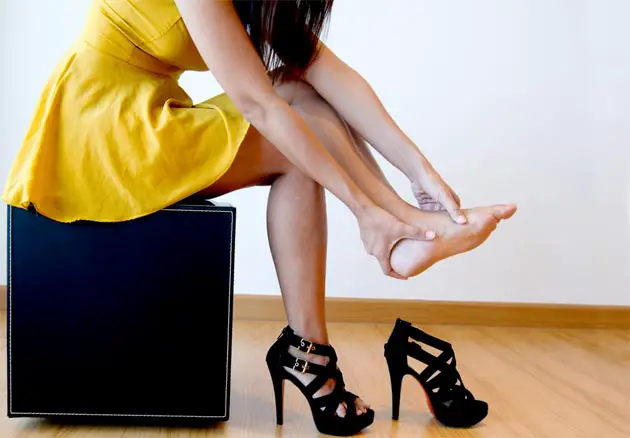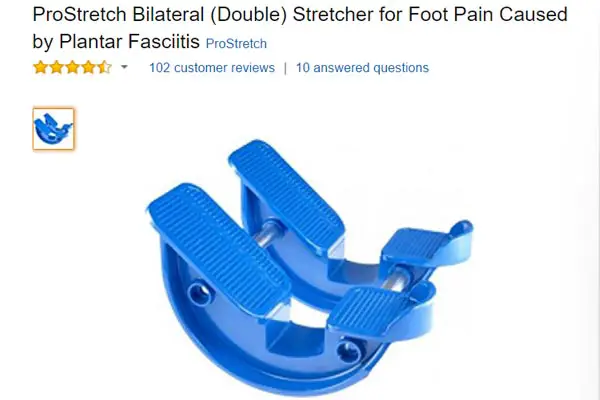Foot pain typically radiates in one localized part of the foot, usually at the bottom of foot (around the heel) or along the arch.
Sometimes, foot pain radiates throughout the entire foot, making it difficult to walk. Though, what if you developed what’s known as bilateral foot pain.
Not only is bilateral foot pain a common foot ailment, but it also affects both foots.
Bilateral Foot Pain ~ Pain In Both Feet
Bilateral foot pain is pain in both feet. This type of pain, as implied, affects both feet at the same time.
Sometimes, the pain manifests in both feet at different times, but the most common form of the condition (which is pretty uncommon itself) affects both feet at the same time.
Both feet contain 26 different bones, 33 joints and 126 muscles, nerves and ligaments in a single complex structure.
Despite all of that, many Americans have problems in both feet. The good news is that a small percentage of Americans are actually born with foot problems, but all of us are prone to developing foot problems at any time in our lives.
They say that as much as 75 percent of Americans will experience some form of foot pain during their lives. Some instances of foot pain develop early in life, while others develop much later in life.
Most people with pain in both feet develop problems after neglecting or improperly caring for their feet.
That typically occurs if you wear improperly fitting shoes or engage in heavy activity throughout most of your life.
Since pain in both feet may develop at any time, it’s important for us to pay attention to how this pain might develop in the first place.
Pain in both feet develops for the same reason any other instance of foot pain occurs. People who are active on a consistent basis are more prone to developing this form of foot pain over others.
Bilateral foot pain occurs anywhere in both feet. Pain may develop within the heel, between the toes, along and in the arch, within the instep and at the bottom of each foot.
The main causes of pain in both feet include:
- Staying on your feet for prolonged periods of time
- Having any kind of foot deformity
- Wearing poorly fitting shoes or shoes without any cushioning
- Participating in too much activity, such as walking, exercise or other intense sports
- Being overweight or obese
- Aging
- Injury

Other sources of foot pain in both feet exist, though the following might be more uncommon than the aforementioned causes:
- Arthritis, including gout, which can cause the toes to become swollen and tender.
- Bunions, a type of bump that appears at the big toe’s base from forced or improper bone alignment.
- Calluses and corns, or hardened skin from excessive rubbing and/or pressure. Both respectively appear on the bottom of the feet or heels (calluses) or on the toes (corns).
- Hammer toes, or downward curling toes that form into a ‘claw.’
- Fallen arches or flat feet.
- Morton’s neuroma, a condition describing thickened nerve tissue in between the toes.
- Diabetes-related nerve damage.
- Stress fractures or other broken bones.
- Plantar fasciitis.
- Sprains and strains.
As mentioned, pain in both feet manifests much like any other form of foot pain, though in both feet this time around.
To better understand how pain in both feet develops, we’re going to look closer at some of the most common causes of pain in both feet in the next section.
Bilateral Pain In The Feet ~ Examining The Causes Of Foot Pain
As mentioned in the previous section, pain in both feet or bilateral foot pain originates from many causes.
The most common causes, such as prolonged activity and lacerations/sores on the feet, are simple to treat in most cases of bilateral foot pain.
Other causes of bilateral foot pain, however, require a little more explanation to get the general idea behind each. In this section, we’re going to take a brief look at some of those conditions.
Toe bursitis
This condition occurs when the fluid filled sacs around your toe joints become inflamed.
These sacs actually help protect the toes, especially the big toe. When the toes develop bursitis, it’s usually because the toes have irritation from excessive repetitive movements or rubbing.
Ingrown toenails
These occur on any toe, though the big toe is the most common. They typically develop if you wear tight or narrow fitting shoes, which place too much pressure on the outside of your big toe.
Sometimes, it can affect the little toe, since the opposing side of the ill-fitting shoe likely exerts the same amount of pressure as the other side.
Other conditions also cause ingrown toenails to develop on both feet, including fungal infections and toe injuries.
Stress fractures
Stress fractures in the feet occur in any of their five metatarsal bones, usually the second or third.
These fractures occur after the structure of each foot wears down from overuse using high impact and strenuous exercise.
Stress fractures occur in other bones, but they commonly develop in the metatarsal bones.
Tarsal tunnel syndrome
Tarsal tunnel syndrome develops from nerve compression in both the ankle and foot. The affected nerve runs through a narrow passage located behind the inner anklebone and down the heel.
This condition develops after injuries to the ankle, such as a fracture or sprain. Sometimes, growths that press against that nerve cause the condition to develop.
Heel pain
Heel pain is probably the most common source of pain in both feet. It develops in the front, back or at the bottom of each heel.
It’s so common that it affects as much as 2 million Americans throughout each year.
Excessive pronation
Pronation is what allows the feet to adapt when walking across uneven surfaces. It also helps the feet absorb shock.
Excessive pronation happens when the feet start turning outward, which has the effect of flattening the feet’s longitudinal arches and stretching out their fascias.
This condition not only causes pain in both feet, but it also causes other problems in the knees, hips and, sometimes, the lower back.
